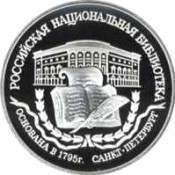
The first Russian State public library founded. The All-Russian Library Day
On May 16 (27), 1795 Empress Catherine the Great approved the project by architect E. T. Sokolov of the construction of the Imperial Public Library (now the National Library of Russia), one of the largest book depositories in the world. It was the first building in Russia intended specially for housing a library.
The tradition of collecting books originates from the Ancient Russia. Its development began in 18th century. Aristocratic and rich families started to create their private libraries. However these private collections could not contribute in full measure to the formation of the Russian intelligentsia among ‘educated nobles’ and extend the stratum of educated ‘statesmen’. The state departmental libraries such as the Academy of Science library and the Academy of Arts library had not solved the problem either. Thus the Imperial Library intended for the ‘public enlightenment of Russians’, was organized as a public one meant to symbolize the power of the Russian state.
The Public Library construction had lasted for almost 20 years: from 1795 to 1814. It had been under Catherine’s personal control: she regularly heard the accounts on the course of the construction works and made decisions regarding the Library’s future. The construction financing was provided by the Cabinet of Empress ‘oral personal orders’.
In July of 1796 Catherine II revised architectural projects by E. T. Sokolov. In accordance with one of them it was decided to add an observatory to the library’s building. The Empress gave over for general use the telescope of a known English astronomer V. Gershel so that the visitors could observe the night sky.
When Paul I accessed the power, the Library’s construction had stopped. It was a Russian sponsor count A. S. Stroganoff who saved the situation. Being appointed the Director General of the Imperial Libraries he had persisted that the Imperial Public Library did not cease to exist.
On Stroganoff’s request Alexander I had acquired and granted to the Library the collection of manuscripts of P. P. Dubrovsky, a former official of the Russian embassy in Paris, an ardent bibliophile, a collector of Ancient Slavic and Eastern manuscripts, letters of Western scholars and writers of 16-18th centuries. On the basis of this collection in 1805 a special depository – ‘Manuscripts depot’ was created in the Library. It was soon replenished by the most valuable monuments of the Ancient Russian scripts including Ostromir Gospels (1056-1057) and Laurentian Codex (1377), a collection of chronicles including the oldest extant version of the Primary Chronicle.
In 1808 Stroganoff chose A. N. Olenin as an assistant for the Library management. He was appointed the Library’s Director Deputy; and after Stroganoff’s death became the Public Library Director.
In 1809 Olenin published the first Russian guide on funds and catalogues arrangement ‘A new bibliographic order of St. Petersburg Public Library’. In 1810 Emperor Alexander I by a special rescript ordered to open the new establishment ‘for the general benefit’ and approved ‘The Regulations on the Imperial Public Library management’ by Olenin. The Regulations stipulated the general principles of the Library work order; outlined the duties of a librarian and a manuscripts curator and determined the Library’s staff and structure.
On January 2 (14), 1814 took place the ceremony of the grand opening of the Imperial Public Library.
Under the order of the RF President B. N. Yeltsin of May 27, 1995 the day of the establishment of the first State Public Library in Russia was henceforth celebrated as the All-Russian Library Day.
Lit.: Российская национальная библиотека: историческая справка [Электронный ресурс] // Российская национальная библиотека. 1998-2016. URL: https://nlr.ru/history_nlr; Об установлении общероссийского Дня библиотек: указ Президента РФ от 27 мая 1995 г. N 539 // Российская газета. 1995, 2 июня. N 106.
Российская национальная библиотека: сайт. 1998-2016. URL: http://www.nlr.ru/.
Based on the Presidential Library’s materials:

